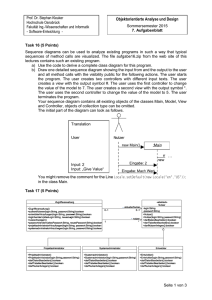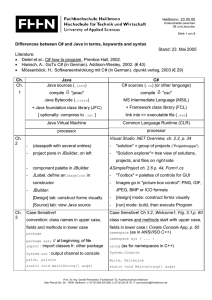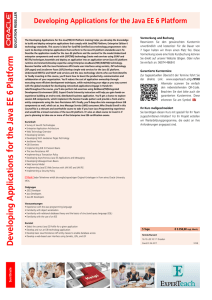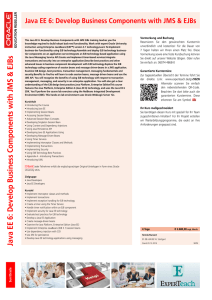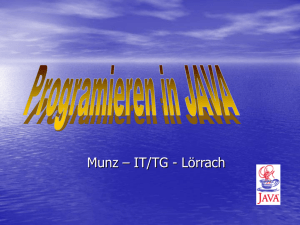Java Arrays - Helmut Dispert
Werbung
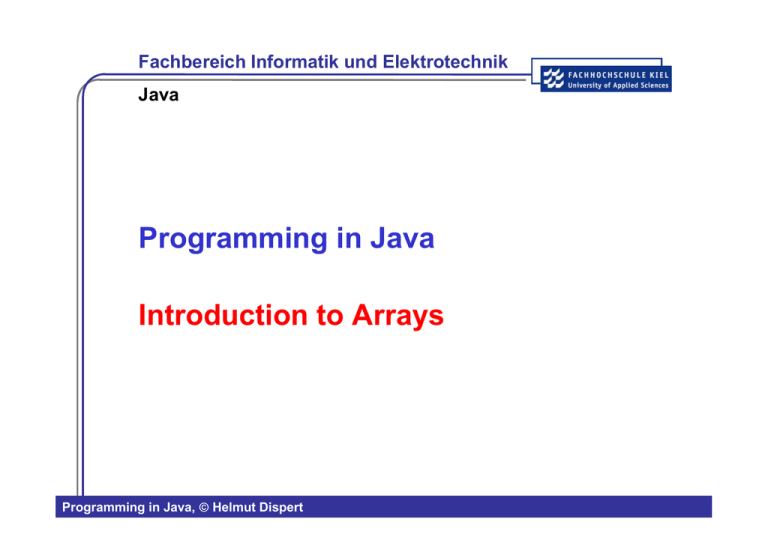
Fachbereich Informatik und Elektrotechnik
Java
Programming in Java
Introduction to Arrays
Programming in Java, Helmut Dispert
Fachbereich Informatik und Elektrotechnik
Java Objects
Class-Definition:
Template (blueprint, prototype) of an object.
Methods
Variable Declarations
Object-Definition:
Software unit of variables (data) and related
methods.
Programming in Java, Helmut Dispert
Fachbereich Informatik und Elektrotechnik
Java – The Array Concept
Array:
Array object (object oriented)
Collection of items,
group of memory locations
Properties of Arrays:
Definite sequence (linear or multidimensional)
Fixed length, established when the array is created
The individual items are called elements
The elements are selected by a number called an index,
in Java, the index is of type "int" starting from zero
Programming in Java, Helmut Dispert
Fachbereich Informatik und Elektrotechnik
Java – The Array Concept
position number
index (int)
0
1
2
3
4
5
6
7
8
9
ArrayName 47 11 05 14 14 36 04 03 02 01
Name of Array
Array Element
Programming in Java, Helmut Dispert
ArrayName[0]
ArrayName[1]
ArrayName[2]
ArrayName[3]
...
=
=
=
=
47
11
05
14
Fachbereich Informatik und Elektrotechnik
Java – The Array Concept
Specifying an element:
a[4]
a
0
1
2
3
4
5
6
Array length: n elements from
... n-1
0 to n-1
In Java arrays are semidynamic:
the size (length) will be defined at run-time,
but it cannot be changed anymore.
Programming in Java, Helmut Dispert
index
Fachbereich Informatik und Elektrotechnik
Java – How to create an array
1. Declaration
2. Creation, Initialisation
Similar to normal variables
Declaration:
double [ ] salary;
Student [ ] friends;
preferred form
Square brackets indicate array.
Optional form of declaration (for compatibility with C/C++):
double salary[ ];
Student friends[ ];
Programming in Java, Helmut Dispert
less preferred form
Fachbereich Informatik und Elektrotechnik
Java – How to create an array
Creation, Initialisation:
Creation must specify the length
salary = new double[3];
friends = new Student[7];
array constructor
Declaration and Initialisation can be combined in
one statement:
double [ ] salary = new double[3];
Student [ ] friends = new Student[7];
Programming in Java, Helmut Dispert
Fachbereich Informatik und Elektrotechnik
Java – How to create an array
new operator:
used to create an instance of an array object in
memory (reserving the required number of memory
locations – allocation of memory).
The attempt to assign values to array elements or to access them
before memory has been allocated the compiler will issue an
error message like:
Variable salary may not have been initialized.
Arrays are objects.
Immediately after creation the array contains zeroes or
nulls.
Programming in Java, Helmut Dispert
Fachbereich Informatik und Elektrotechnik
Java – Primitive Arrays
Primitive Java arrays contain zeroes after creation:
0.0 0.0 0.0
salary
0
1
2
Abbreviated diagram:
salary
0.0 0.0 0.0
0
Programming in Java, Helmut Dispert
1
2
Fachbereich Informatik und Elektrotechnik
Java – Primitive Arrays
Array elements can be used in all contexts appropriate for
the type:
- e.g.:
salary[1] = 56000.0;
System.out.println(salary[1] + salary[2]);
The array index can be a variable:
- e.g.:
int i = 0;
x = (salary[i] + salary[i+1])/2;
Programming in Java, Helmut Dispert
Fachbereich Informatik und Elektrotechnik
Java – Arrays of Objects
Immediately after creation the array contains null
references – no element objects exist:
friends null null null null null null null
0
1
2
3
4
5
6
4
5
6
Element objects must be created:
- e.g.:
friends[4] = new Student();
friends
0
Programming in Java, Helmut Dispert
1
2
3
Fachbereich Informatik und Elektrotechnik
Java – Arrays of Objects
Some element can remain null
(code may have to check this)
friends
null null
0
1
2
3
null null
4
5
6
Elements can be used like single objects
- e.g.:
friends[4].readMarks();
System.out.println(friends[i].getName() +
"lives beside" + friends[i+1].getName());
Remember: friends[0] is the "first" element, friends[1] the "second"
Programming in Java, Helmut Dispert
Fachbereich Informatik und Elektrotechnik
Java – Arrays Bounds
Arrays "know" their length, and can be queried
- Use the public attribute length
- e.g.:
n = friends.length;
Arrays protect against illegal accesses "off the ends" or
"out of bounds"
- i.e. attempts to use an index value outside the range
0 to (length – 1)
- e.g. friends[7].readMarks(); is illegal
- unless code is written to handle this, the program
crashes with an
ArrayIndexOutOfBoundsException
Programming in Java, Helmut Dispert
Fachbereich Informatik und Elektrotechnik
Java – Arrays and for-Loops
For-loops are ideal for use with arrays.
Examples:
int count;
double[ ] stairs;
count = Keyboard.readInt("how many stairs do you want?");
stairs = new double[count];
// initialise:
for (int i=0; i<count; i++)
{
stairs[i] = (i + 1)*0.19; // metres above ground
}
count
4
stairs
0.19 0.38 0.57 0.76
0
Programming in Java, Helmut Dispert
1
2
3
Fachbereich Informatik und Elektrotechnik
Java – Arrays and for-Loops
Examples (continued):
n must be ≥ 0
// creation
friends = new Student[n]
for (int i=0; i<n; i++)
{
friends[i] = new Student();
}
// sending the same message to each student:
for (int j=0; j<n; j++)
{
friends[j].readMarks();
}
Programming in Java, Helmut Dispert
Fachbereich Informatik und Elektrotechnik
Arrays – Common Programming Errors
Animal[ ] a;
for (int i=0; i<5; i++)
{
a[i].makeNoise();
}
// raises NullPointerException
Animal[ ] a = new Animal[5]; // legal
for (int i=0; i<=5; i++)
{
a[i] = new Animal();
// raises
// ArrayIndexOutOfBoundsException
}
Animal[ ] a = new Animal[5]; // legal
a.makeNoise();
// compile time error
Programming in Java, Helmut Dispert
Fachbereich Informatik und Elektrotechnik
Arrays – Common Programming Errors
Look carefully!
Animal[ ] a = new Animal[5]; //legal
for (int i=0; i<5; i++);
{
a[i].makeNoise();
}
Programming in Java, Helmut Dispert
// compile or run-time error
// depending on visibility and
// value of another i
Fachbereich Informatik und Elektrotechnik
Arrays – Common Programming Errors
Programming in Java, Helmut Dispert
Fachbereich Informatik und Elektrotechnik
Arrays – Common Programming Errors
public class Frequencies
{
public static void main(String[] args)
{
final int n=6000, faces=6; // constants
int[] count = new int[faces];
int toss;
double randomValue;
// simulate n tosses of the die
for (int j=0; j < n; j++)
{
randomValue = Math.random();
// 0.0 <= r < 1.0
toss = (int)(randomValue * faces); // 0 to 5
count[toss]++;
}
e.g. 0.51
(int) (3.06)
Programming in Java, Helmut Dispert
Fachbereich Informatik und Elektrotechnik
Arrays – Common Programming Errors
System.out.println("face\tcount");
for (int j=0; j<faces; j++)
{
System.out.println((j+1) + "\t" + count[j]);
}
}
}
C:\JavaLecCode>javac
Frequencies.java
Java
Programming in Java, Helmut Dispert
C:\JavaLecCode>java Frequencies
face
count
1
990
2
1002
3
1041
4
960
5
1005
6
1002
Fachbereich Informatik und Elektrotechnik
Java – Multidimensional Arrays
The arrays introduced so far were limited to one dimension only.
Multidimensional arrays can be implemented as arrays of arrays.
Example: Array of two dimensions
public class MultArray
{
public static void main(String[] args)
{
int[][] a = new int[2][3];
a[0][0]
a[0][1]
a[0][2]
a[1][0]
a[1][1]
a[1][2]
=
=
=
=
=
=
1;
2;
3;
4;
5;
6;
c:\JavaLecCode>javac MultArray.java
c:\JavaLecCode>java MultArray
123
456
System.out.println(""+a[0][0]+a[0][1]+a[0][2]);
System.out.println(""+a[1][0]+a[1][1]+a[1][2]);
}
}
Programming in Java, Helmut Dispert
Java
Fachbereich Informatik und Elektrotechnik
Java – Initialising Arrays
int
steps[]
= {91,92,93,94};
int
matrix[][] =
{
{0,1,0,1},
{1,0,1,0},
{0,1,0,1},
{1,0,1,0},
};
Programming in Java, Helmut Dispert
Fachbereich Informatik und Elektrotechnik
Java – Dynamic Arrays
The Java language has a dynamic memory allocation model, therefore
arrays can be dimensioned at run time (in contrast to languages such as C).
But, once an array is dimensioned it cannot be modified (e.g. extended).
Help:
Java supports several collection types that allow the definition of structures
that can hold a series of objects, even if the exact number of objects is not
known yet.
e.g.
Vectors (linear list)
ArrayLists (in Java 2)
Disadvantage:
The information is not stored sequentially in memory, so their use is less
efficient as with an array.
See:
JDK 1.2 Collections-Framework
java.util
Programming in Java, Helmut Dispert
Javadoc
Fachbereich Informatik und Elektrotechnik
Arrays – Key Terms
•
•
•
•
•
•
•
array
array bounds
base type
double
element
index
length attribute
Programming in Java, Helmut Dispert
Fachbereich Informatik und Elektrotechnik
Strings
• Every string we create is actually an object of type String. Even
string constants are actually String objects.
• Objects of type String are immutable; once a String object is
created, ist contents cannot be altered:
• If we need to change a string, we can always create a new one
that contains the modification
• Java defines a class called StringBuffer, which allows strings
to be altered.
• String class contains several methods. Some of them are:
We can test two strings for equality by using equals():
(String object)
We can obtain the length of a string by calling the length()
method:
int length()
We can obtain the character at a specified index within a string
by calling charAt():
char charAt(int index)
Programming in Java, Helmut Dispert
Fachbereich Informatik und Elektrotechnik
Strings
The String Class
A string is an object of type String
(this also includes string constants).
Once created, Strings cannot be altered anymore.
String
0
1
2
3
4
5
6
... n-1
Elements of type char (UNICODE)
Strings that can be altered: use StringBuffer
Programming in Java, Helmut Dispert
Fachbereich Informatik und Elektrotechnik
Strings
Methods of class String:
Method
Function
boolean equals (String object)
Test strings for equality
int length()
Return length of string
char charAt (int index)
Return character at specified
index position
substring(int begin, int end)
Return specified substrings
result
substring
begin
Programming in Java, Helmut Dispert
end
Fachbereich Informatik und Elektrotechnik
Method String.equals()
class EquTest
{
public static void main(String args[])
{
String str1, str2;
str1 = "FH Kiel, FB Elektrotechnik";
str2 = str1;
Java
System.out.println("String: " + str1);
System.out.println("String: " + str2);
System.out.println("Same Object? " + (str1 == str2));
str2 = new String(str1);
System.out.println("String: " + str1);
System.out.println("String: " + str2);
System.out.println("Same Object? " + (str1 == str2));
System.out.println("Same value? " + str1.equals(str2));
}
}
Programming in Java, Helmut Dispert
continued
Fachbereich Informatik und Elektrotechnik
Method String.equals()
Output:
String: FH Kiel, FB Elektrotechnik
String: FH Kiel, FB Elektrotechnik
Same Object? true
String: FH Kiel, FB Elektrotechnik
String: FH Kiel, FB Elektrotechnik
Same Object? false
Same value? true
Programming in Java, Helmut Dispert
Fachbereich Informatik und Elektrotechnik
Input / Output
Command Line Input:
main (String args[])
{...}
Array of Strings
Command args[0] args[1]
…
args[n-2] args[n-1]
Argument 1
Argument 2
Argument n-1
Argument n
String Arguments
Programming in Java, Helmut Dispert
Fachbereich Informatik und Elektrotechnik
Input / Output
Array of Strings (has to be converted):
Integer.parseInt (args[...]);
Standard Output:
System.out.print(...);
System.out.println(...);
// no
<CR>,<LF>
// with <CR>,<LF>
Obs.:
Output with “print” will be buffered;
at least one “println” is necessary to terminate a sequence of output operations.
Programming in Java, Helmut Dispert
Fachbereich Informatik und Elektrotechnik
Command Line Input
class helloCLI
/** HelloWorld with Command Line Input
*/
{
public static void main(String args[])
{
int i;
System.out.print("Hello ");
for (i=0; i < args.length; i = i+1)
{
System.out.print(args[i]);
System.out.print(" ");
}
System.out.println();
// new line
}
}
Programming in Java, Helmut Dispert
Fachbereich Informatik und Elektrotechnik
Numerical Command Line Input
class helloCLIn
/** HelloWorld with numerical Command Line Input
{
public static void main(String args[])
{
int i, sum=0;
System.out.print("Hello ");
for (i=0; i < args.length; i = i+1)
{
sum += Integer.parseInt(args[i]);
}
System.out.println("Result: " +sum);
}
}
Programming in Java, Helmut Dispert
*/
